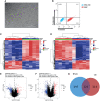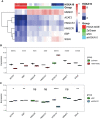HOXA10 Regulates the Synthesis of Cholesterol in Endometrial Stromal Cells
- PMID: 35546998
- PMCID: PMC9084188
- DOI: 10.3389/fendo.2022.852671
HOXA10 Regulates the Synthesis of Cholesterol in Endometrial Stromal Cells
Abstract
Background: The expression of homeobox A10 (HOXA10) in endometrial stromal cells is regulated by steroid hormones, especially by estrogen. As a precursor molecule of estrogen, abnormal cholesterol metabolism is significantly positively correlated with endometriosis. The purpose of this study was to explore the regulation of HOXA10 on cholesterol synthesis in endometrial stromal cells.
Method: mRNA expression data of eutopic endometrial stromal cell (ESC) and ovarian endometriotic cysts stromal cell (OESC) were download from the Gene Expression Omnibus (GEO) databases. Overexpression and silence of HOXA10 were conducted in cultured ESC and subjected to mRNA sequencing. The differentially expressed genes (DEGs) were selected by analyzing the sequencing data. Weighted gene co-expression network analysis (WGCNA) was applied to identify the key genes associated with HOXA10. The methylation rate of HOXA10 CpGs and the correlation between HOXA10 expression and the methylation in eutopic endometrial tissue (EU) and ovarian cyst (OC) were analyzed.
Results: HOXA10 in ESC was significantly higher expressed than that in OESC. Six key genes (HMGCR, MSMO1, ACAT2, HMGCS1, EBP, and SQLE), which were regulated by HOXA10, were identified from the salmon4 module by WGCNA. All these key genes were enriched in cholesterol synthesis. Moreover, the expression of HOXA10 was negatively related to its CpGs methylation rate.
Conclusion: In this study, six key genes that were regulated by HOXA10 were selected, and all of them were enriched in cholesterol synthesis. This finding provided a new insight into the metabolic mechanism of cholesterol in ESC. It also provided a potential treatment strategy for cholesterol metabolism maladjustment in patients with ovarian endometriosis.
Keywords: HOXA10 gene; cholesterol synthesis; endometrial stromal cell; estrogen; ovarian endometriosis.
Copyright © 2022 Yu, Tang, Huang, Guo, Du, Li and Quan.
Conflict of interest statement
The authors declare that the research was conducted in the absence of any commercial or financial relationships that could be construed as a potential conflict of interest.
Figures







Similar articles
-
Altered expression of HOXA10 in endometriosis: potential role in decidualization.Mol Hum Reprod. 2007 May;13(5):323-32. doi: 10.1093/molehr/gam005. Epub 2007 Mar 9. Mol Hum Reprod. 2007. PMID: 17350963
-
MicroRNA 135 regulates HOXA10 expression in endometriosis.J Clin Endocrinol Metab. 2011 Dec;96(12):E1925-33. doi: 10.1210/jc.2011-1231. Epub 2011 Sep 28. J Clin Endocrinol Metab. 2011. PMID: 21956427 Free PMC article.
-
Aberrant endometrial DNA methylome of homeobox A10 and catechol-O-methyltransferase in endometriosis.J Assist Reprod Genet. 2017 Mar;34(3):409-415. doi: 10.1007/s10815-016-0862-6. Epub 2017 Jan 10. J Assist Reprod Genet. 2017. PMID: 28074437 Free PMC article.
-
Role of HOXA10 in pathologies of the endometrium.Rev Endocr Metab Disord. 2025 Feb;26(1):81-96. doi: 10.1007/s11154-024-09923-8. Epub 2024 Nov 5. Rev Endocr Metab Disord. 2025. PMID: 39499452 Review.
-
The role of the Hoxa10/HOXA10 gene in the etiology of endometriosis and its related infertility: a review.J Assist Reprod Genet. 2010 Dec;27(12):701-10. doi: 10.1007/s10815-010-9471-y. Epub 2010 Sep 7. J Assist Reprod Genet. 2010. PMID: 20821045 Free PMC article. Review.
Cited by
-
The Effect of Metformin and Carbohydrate-Controlled Diet on DNA Methylation and Gene Expression in the Endometrium of Women with Polycystic Ovary Syndrome.Int J Mol Sci. 2023 Apr 6;24(7):6857. doi: 10.3390/ijms24076857. Int J Mol Sci. 2023. PMID: 37047828 Free PMC article.
-
Bidirectional causality between the levels of blood lipids and endometriosis: a two-sample mendelian randomization study.BMC Womens Health. 2024 Jul 4;24(1):387. doi: 10.1186/s12905-024-03213-w. BMC Womens Health. 2024. PMID: 38965508 Free PMC article.
-
miR-584-5p Regulates MSMO1 to Modulate the AKT/PI3K Pathway and Inhibit Breast Cancer Progression.Protein Pept Lett. 2025;32(3):171-182. doi: 10.2174/0109298665339026250114070523. Protein Pept Lett. 2025. PMID: 39950465
-
Global Whole-Genome Resequencing of Beef Cattle Reveals Characteristic Traits Related Genes in Pinan Cattle.Animals (Basel). 2025 May 31;15(11):1626. doi: 10.3390/ani15111626. Animals (Basel). 2025. PMID: 40509092 Free PMC article.
-
The Effect of Granulocyte Colony-Stimulating Factor on Endometrial Receptivity of Implantation Failure Mouse.Reprod Sci. 2025 Jan;32(1):200-217. doi: 10.1007/s43032-024-01527-6. Epub 2024 Apr 10. Reprod Sci. 2025. PMID: 38600416
References
MeSH terms
Substances
LinkOut - more resources
Full Text Sources
Medical
Research Materials

